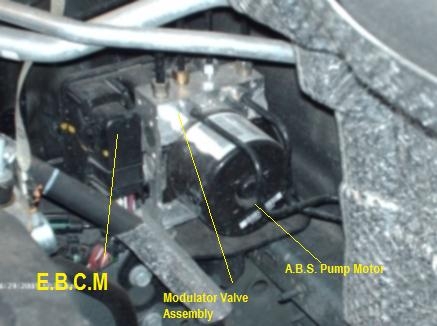
Anti-lock brake systems (ABS) prevent wheels from locking during panic stops or in slippery driving conditions. The system electronically monitors individual wheel speed; when it senses a wheel is about to lock up, it releases that wheel's brake. When the system has problems, it can be costly to repair. Knowing what causes the problems can help keep repair bills under control.
The ABS functions in four modes during brake operation: monitor, hold/isolate, release/dump, and reapply.
In monitor mode, the ABS is monitoring and comparing the wheel speed sensors. If there is no brake pedal input or wheel lock, this is the normal mode of operation.
In hold/isolate mode, the system has sensed one or more wheels drop to a speed slower than the others. It calculates that the wheel is about to lock up and energizes the isolation solenoid to prevent additional brake pressure from being applied.
To regain control, the ABS de-energizes the isolation solenoid and energizes the release/dump solenoid, allowing the wheel to spin and regain traction. The pressurized brake fluid is routed and stored in an accumulator where it stays until it is released back into the system.
In reapply mode, the stored brake fluid is pressurized and reapplied to the brakes to continue to slow the vehicle.
This sequence of modes is repeated until normal brake function is regained. The ABS in late-model vehicles can cycle more than 15 times a second.
The input devices are called wheel speed sensors. They are magnetic inductors that generate an AC signal or, in the case of vehicles with electronic brake proportioning systems, a DC wave. The signal strength and frequency increases or decreases according to wheel speed. Early speed sensors were located in the differential; later systems are in the axle or hub bearing.
The output devices are known as solenoid valves. The valves and their coils are located in the modulator valve assembly. The valves open when a coil is energized and a magnetic field builds around it. The iron stem of the valve moves to center itself in the magnetic field, which opens the valve.
The electronic brake control module (ECBM) is the computer that calculates wheel speed according to sensor input and then energizes the appropriate solenoid valve to control the mode.
The most common causes of ABS failure involve the wheel speed sensors. The No. 1 cause of an ABS light activating is a contaminated wheel speed sensor. Since the sensor is magnetic, it attracts metal particles in the brake pads. These particles stick to the sensor and dampen the signal. Cleaning the sensor usually restores proper function. If the metal buildup is severe, the particles can wedge between the sensor and its tone ring and crack the sensor. When this occurs, water and grit quickly deteriorate the wiring and chip in the sensor and destroy it.
Another common cause of ABS failure is corrosion in the modulator valve assembly. This is caused by a failure to change the brake fluid. As the fluid absorbs moisture to the point of saturation, the water attacks the metal components in the valve assembly, causing the valves to stick open or closed.
Problems related to premature lockup or no ABS action can be traced to incorrect wheel diameter or mismatched wheel diameter. The trend of replacing factory wheels and tires with larger diameter wheels can cause problems with not only ABS but with the speedometer and other systems.
There are two remedies. The first is to use tires with the correct outside diameter. As long as the tire is the right diameter, the wheel can be whatever diameter you wish. The second remedy is to recalibrate the vehicle's computer to compensate for the diameter change. Cars and trucks using the CAN (controller area network) computer protocol have this function.
Precautions when selecting tires and proper maintenance of the system will prevent most ABS problems. Change your brake fluid as directed in your owner's manual or have an authorized service center do it for you.